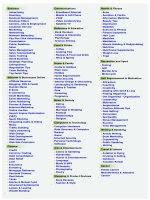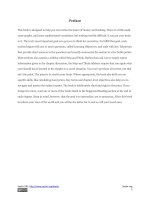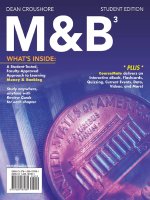Money and Banking: Lecture 34
Bạn đang xem bản rút gọn của tài liệu. Xem và tải ngay bản đầy đủ của tài liệu tại đây (832.2 KB, 28 trang )
Money and
Banking
Lecture 34
McGrawHill/Irwin
Copyright © 2006 by The McGrawHill Companies, Inc. All rights reserved.
Review of the Previous Lecture
• Changing the Size and Composition of the
Balance Sheet
•
•
•
•
Open Market Operation
Foreign Exchange Intervention
Discount Loans
Cash Withdrawals
Deposit Creation in a Single Bank
• If the central bank buys a security from a
bank, the bank has excess reserves,
which it will seek to lend
• The loan replaces the securities as an
asset on the bank’s balance sheet.
Central Bank’s
• Assuming First bank has granted a loan of
$100,000 to Office Builders Incorporated
(OBI)
Central Bank’s
• OBI paid off its employees and suppliers
through checks worth $100,000
Central Bank’s
Deposit Expansion in a System of
Banks
• The loan that the First bank made was
spent and as the checks cleared, reserves
were transferred to other banks
• The banks that receive the reserves will
seek to lend their excess reserves, and
the process continues until all of the funds
have ended up in required reserves
Types of Reserves
• Actual Reserves (R)
• Required Reserves (RR=rDD)
• Excess Reserves (ER)
• Assume
• Bank hold no excess reserves.
• The reserve requirement ratio is 10%
• Currency holding does not change when
deposits and loans change.
• When a borrower writes a check, none of the
recipients of the funds deposit them back in
the bank that initially made the loan.
• Lets say, OBI uses the $100,000 loan to
pay its supplier American Steel Co (ASC),
which it deposits in its bank the Second
bank.
Deposit Expansion Multiplier
•
Assuming
• no excess reserves are held
• there are no changes in the amount of
currency held by the public,
• the change in deposits will be the inverse of
the required deposit reserve ratio (rD) times
the change in required reserves, or
∆D = (1/rD) ∆RR
• Alternatively
• RR = rDD
or ΔRR = rDΔD
• So for every dollar increase in reserves,
deposits increase by
1
rD
• The term (1/rD) represents the simple deposit
expansion multiplier.
• A decrease in reserves will generate a deposit
contraction in a multiple amount too
• RD=10% (0.10), and ΔRR=$100,000
1
$100,000
• ΔD=
.1
• ΔD= $1,000,000
Deposit Expansion with Excess
Reserves and Cash Withdrawals
• The simple deposit expansion multiplier
was derived assuming no excess reserves
are held and that there is no change in
currency holdings by the public.
• These assumptions are now relaxed as
• 5% withdraw of cash.
• Excess reserves of 5% of deposits
• Continuing with our previous example, if
American Steel Co (ASC) removes 5% of
its new funds in cash, which leaves
$95,000 in the checking account and
$95,000 in the Second bank’s reserve
account.
• Bank wishes to hold excessive reserves of
5% of deposits, it would keep reserves of
15% of $95,000 or $14,250 and making a
loan of $80,750
• The desire of banks to hold excess
reserves and the desire of account
holders to withdraw cash both reduce the
impact of a given change in reserves on
the total deposits in the system.
• The more excess reserves banks desire
to hold, and the more cash that is
withdrawn, the smaller the impact.
Money Multiplier
• The money multiplier shows how the quantity
of money (checking account plus currency) is
related to the monetary base (reserves in the
banking system plus currency held by the
nonbank public)
• Taking m for money multiplier and MB for
monetary base, the Quantity of Money, M is
M = m x MB
(This is why the MB is called High Powered Money)









